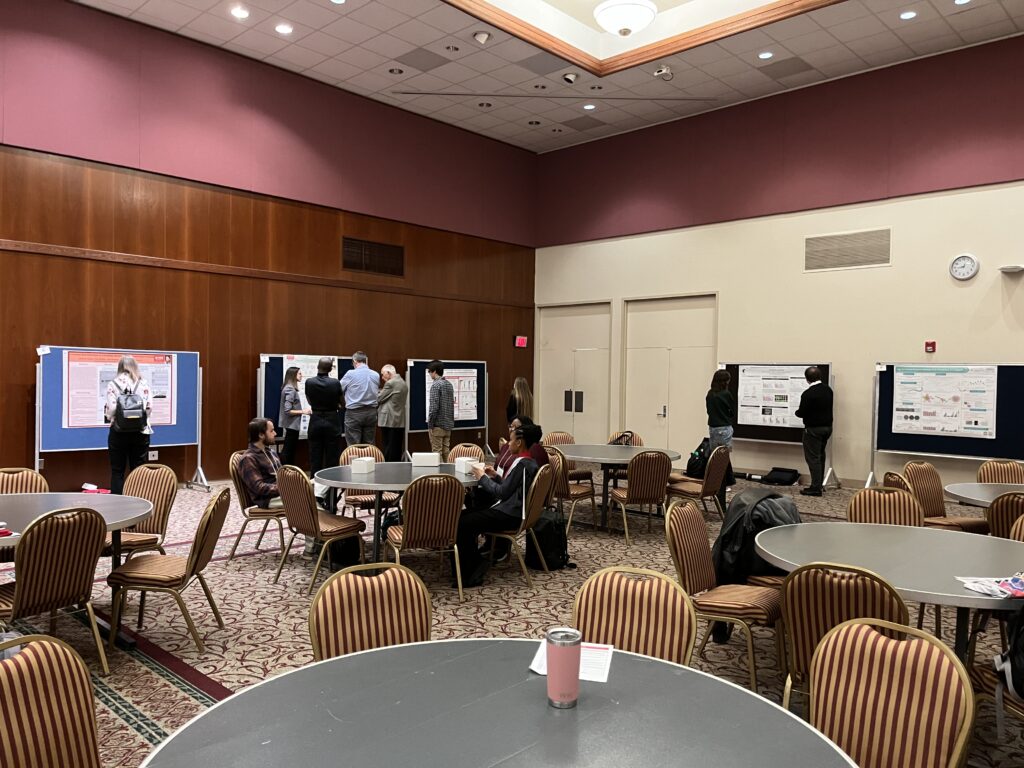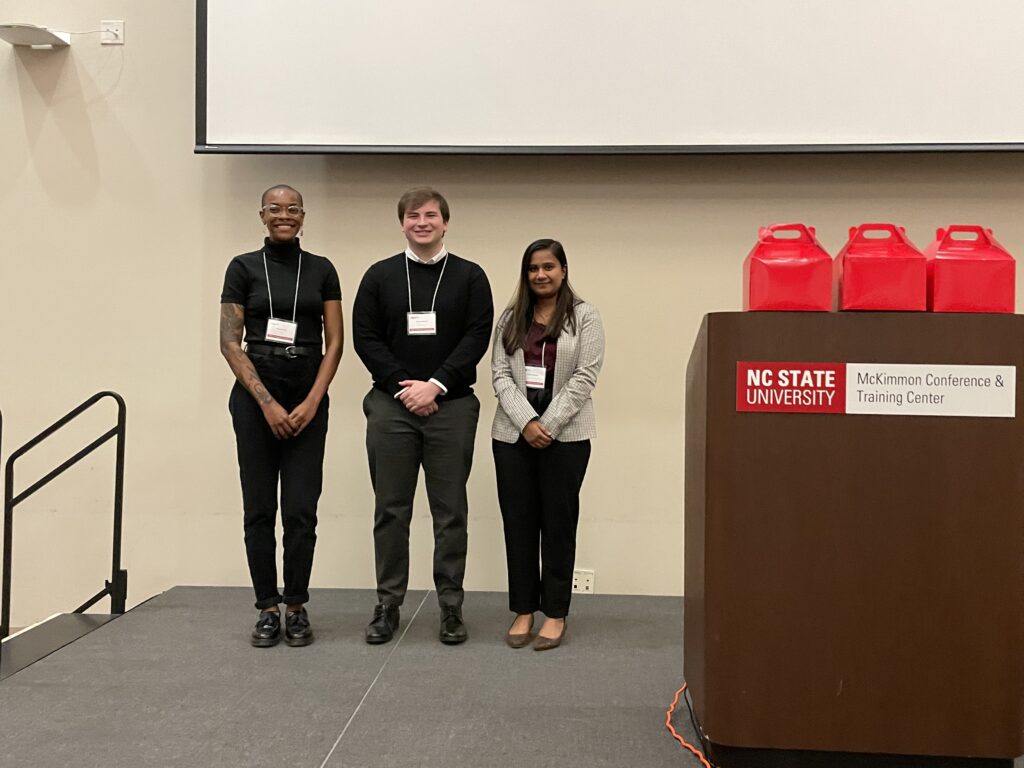The Many Ways of Studying Biotechnology: A Recap of the MBTP 2022-2023 Student Symposium
The annual Molecular Biotechnology Training Program (MBTP) Research Symposium is where MBTP graduate students get to present their research to peers and faculty. Originally scheduled for November 2022, the symposium was moved to March 6th, 2023 in order to observe the added wellness day. Seven students were selected to give an oral presentation on their research and 23 students presented posters. Even though there were 23 students presenting, no two projects were similar. Throughout the entire experience, I was constantly reminded of how vast the field of Biotechnology is and the endless possibilities a program like MBTP creates.

The oral presentations, which lasted approximately 15 minutes each, featured students from many different degree pathways. Michael Bergman, in the Department of Chemical and Biomolecular Engineering, talked about his research on designing polypeptides that could be used to degrade environmental microplastics. Following that, Anna Yaschenko from the Department of Plant and Microbial Biology presented her work on synthetic biology to study gene expression in crops. Chanae Ottley also used crops in her research, although she is from the Department of Electrical and Computer Engineering, and presented how machine learning can be used to assess corn leaves for disease.
Machine learning was the theme of the MBTP Speaker Symposium, which took place on November 9th, 2022. If you’re interested in learning more about machine learning, read the Speaker Symposium article on our page.
I was surprised by how many of the student speakers were early in their PhD careers. For how little time they have been in the lab, on top of balancing classes, all of the students had amazing results already and are still anticipating more. Ana Sheridan is only a 2nd year PhD student who already has promising results for how the homeostasis of pro- and anti-coagulants is maintained in relation to disseminated intravascular coagulation (DIC). Many other students are only in their 3rd year but have many different skills that have made their projects successful.
Anna Yaschenko, who gave an oral presentation and presented a poster, has a background in computer science. I really appreciated how she spent a lot of time focusing on the introduction of synthetic biology and how she created her project. When I spoke to her during the poster session, she told me how she always prioritizes making sure the audience understands why she’s doing what she’s doing, no matter what level of familiarity they may have with the subject. Entering the world of plant biology from computer science showed her that even graduate-level students sometimes need a thorough introduction before they can begin to appreciate your work. When asked what her favorite part of her project is, she said, “Definitely getting to see visual results. Even running a gel and seeing DNA, compared to staring at a computer screen.” In addition to her thorough introduction, she also included a lot of live cell imaging in her presentation, rather than charts and graphs, to try and keep the audience, and herself, engaged throughout the entire presentation
The MBTP program is interdisciplinary, so as I was walking around during the poster session talking to various students, I noticed everyone had very different projects and backgrounds. One second I was talking to a microbiologist, the next a chemist, and then after that a veterinary student. Rachael Gagliardi, a PhD/DVM student in the Comparative Biological Science (CBS) program, is researching fibrinogen’s role in osteoarthritis using the equine model. Her degree and research perfectly reflect her love of both biotechnology and animal science. She mentioned how her favorite part of her project is the discovery and promise of her work, something a DVM might not deliver on its own.
Andrew Ratchford, a 2nd year PhD student, talked to me about his project on using a chemically synthesized product to combat MRSA biofilms. Since Andrew is in the Microbiology Program, I was curious as to how his project was so heavily reliant on chemistry. He explained the collaboration he has with another student in the Pierce Lab, Alejandro Valdes Pena. Alejandro works with vancomycin conjugate synthesis. Vancomycin is a common antibiotic used to treat MRSA. Together, Andrew and Alejandro are able to combine their knowledge of chemistry and microbiology to study MRSA biofilms and find the best chemical syntheses to help find a better solution. Alejandro said “collaboration is key,” and that because of their different specialties, they were able to train each other in various protocols and help bounce ideas that maybe the other person wouldn’t have thought of given their background.
“Don’t underestimate how important it is to tell your scientific story in a way a general scientist can understand.”
– Dr. Jeff Yoder
Although meant as a fun way to present your research to those around you, one of the more stressful parts of the symposium is being judged. However, from what I saw, many of the students leaned into their explanations and conversations with the judges. More often than not it was hard for me to find an unoccupied student to talk to because everyone was having a good time with their judges! After the poster session was over, I pulled Dr. Jeff Yoder aside to talk to him about what it’s like from the judges’ perspective. He has been involved with the MBTP program and judging this symposium for “many years.” He mentioned he is always blown away by the level and quality of science these students can show. Over the years, he’s learned exactly what makes a poster enjoyable. “Don’t underestimate how important it is to tell your scientific story in a way a general scientist can understand. Just because you know it, doesn’t mean you need to explain every detail of it,” he said.
Three individuals each year get to leave the McKimmon Center having the best posters in the room. The judges choose three students with the most impressive poster to win a small prize and the confidence boost that comes along with winning the contest. This year, Kenya Gordon (Department of Physics), Andrew Ratchford (Microbiology Program), and Sneha Mukherjee (Department of Chemical & Biomolecular Engineering) were the three winners. Judges were specifically looking for clear, visually pleasing posters with lots of graphs and figures compared to text. It is also important that students could answer the judges’ questions, provide a quick synopsis that was intriguing yet not overwhelming, and that they personally had performed most of the work presented.

For me, the symposium was a time to learn about great science, catch up with BIT friends over free lunch, and hear the stories of the many PhD students’ experiences. For many of the MBTP graduate students, it was a chance to reconnect with their peers and showcase their research to people outside of their direct cohort. In the end, everyone got to go home feeling fulfilled and confident in their work, and with as many BIT t-shirts as they could hold.
- Categories: